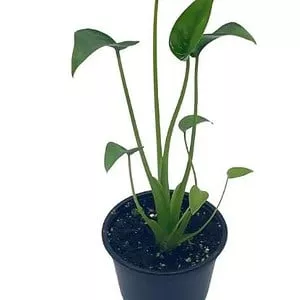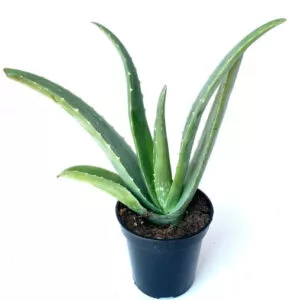No products in the cart.
Table of Contents
Yes, we are over the halfway mark of the year, with fall slowly making its way to our doors. It is an excellent time of the year as we approach October with its Halloween festivities.
So, why not do something different this year? Hide those jack-o’-lanterns away and place some of these scary-looking house plants on the porch.
You will create the right Halloween atmosphere when kids come around trick or treating.
Best Creepy-Looking House Plants to Grow Indoors
Okay, we might not all agree on adding carnivorous plants to the terrifying plants in our homes. But a fact is these creepy plants are the world’s most beautiful collections. They are breathtaking and unique in their way.
So, create a one-of-a-kind horror space to give the Halloween festivities that eerie ambiance with your decorations. We are sure it will be the centerpiece and talked about for years to come.
Resurrection Plant (Selaginella lepidophylla)

Oh, my word, it’s alive! Yes, the resurrection plant is like a zombie returning from the dead. Some gardeners refer to it as the dinosaur or false Rose of Jericho. It looks like spike moss that dries out and dies off.
But somehow, it always comes back to life. First, you receive the plant in a dry state. Then you place them in a dish with distilled water and find a spot with bright indirect sunlight. Then, the fantastic thing, voila, the plant opens in about four hours.
The resurrection plant is a desert species that adapt to different environments and is a very drought-tolerant plant. Okay, maybe that curled-up ball is not such a scary houseplant. But the next one should do the trick.
Brain Cactus (Mammillaria elongata cristata)

The brain cactus or Mammillaria elongata cristata makes a perfect addition to creating a creepy plant collection in the home corner. The only difference is that it does not have the red-pink color or would have looked like the real thing.
The cactus has oval stems that look like the squishy organ in your head. The succulent you find in Central Mexico grows in rocky outcrops. You can grow it in gardens or containers in full sun, reaching only six inches tall.
Still, do not be fooled by this cactus as it has brown spines covering the exterior and blossoms the same color flower in spring. So, it is best to keep it away from small children. Yet, it is a popular indoor plant and water sparingly.
Provide it with well-drained soil and enough drainage and only water when the soil feels dry. With this humble plant in your scary collection, you will surely put your guests in cardiac arrest.
Black Bat Flowers (Tacca chantrieri)

Who needs ornamental bats if you can have black bat flowers in your home to give that eerie feeling? The mysterious plant resembles bats in flight as the large petals resemble bats, giving it that nocturnal name.
It has a dark purple with ruffled orchid blooms found in tropical to semi-tropical regions, but it prefers shade and not direct sunlight. Hence, it will fit in well with your houseplant collection. But if you are brave to have the species in the home, prepare yourself to repot it yearly.
Mangave ‘Desert Dragon’

The Mangave Desert Dragon might not look as scary as other plants. Still, those long narrow grayish-green leaves with brownish-purple spots will make it look like it belongs in a fairytale Halloween theme.
The plant’s sprawl out from the ground low, looking like a spider-like heap. It is a fast-growing plant needing bright light with regular watering. Yet, if you neglect the task, the succulent lives up to the name. It is drought tolerant for long periods and hard to grow in warmer regions outdoors.
Corpse Flower (Amorphophallus titanum)

The corpse flower will do the trick if you want to put your guests in a frenzy. That is if you can get it to bloom at the right time. The flowers smell like death or rotting flesh. It will be a popular houseplant, but it takes years before it blooms.
The disgusting fragrance is sure to imitate dead animals, but it does attract pollinators, from flesh flies to dung beetles. But do not think that the corpse flower is carnivorous species. No, it lives in the soil and thrives in moisture with sunlight.
Venus Flytrap (Dionaea muscipula)

Who does not know this carnivorous plant from the Little Shop of Horrors? Yet, it fits perfectly into a scary scene. The venus flytraps are popular houseplants that feed on insects as food to receive all the essential nutrients.
But be careful not to place your finger on those pads as they snap shut in seconds. The fact is that this creepy carnivore is a beautiful plant. It has showy-edged red-to-green foliage with teeth like cilia, and its favorite snack is spiders.
The venus flytrap enjoys ants, grasshoppers to beetles. Luckily they do not prefer humans as a treat.
Doll’s Eyes (Actaea pachypoda)

You can scare people out of their wits with the doll’s eyes or white baneberry. The famous garden plant is native to North America and features white berries with a dark spot resembling eyes to give that doll’s eye look.
So if you have seen the movie Dolls, this plant will keep you looking at them at night. Another thing to be aware of is that it has toxic leaves and is best to keep it away from small children and pets. Choose a site with indirect light and well-drained soil to keep this baby flourishing.
Cobra Plant (Darlingtonia californica)

Okay, you must agree it does look like a snake hence the name cobra plant. But growing these plants as houseplants is tricky. It thrives with icy purified water. It is native to the Pacific Northwest, growing in water, and fed by freezing water.
The roots need to be kept cool, and it is a carnivorous species. So on a hot summer’s day, it helps to place an ice cube on the soil to keep it refreshing and cool. Neither does it survive in direct sunlight and prefers partial shade.
Spider Plants (Humata tyermanii)

The spider fern or rabbit’s foot makes an excellent addition to a spooktacular plant in the home. It is a classic plant with furry roots that cascade from a pot to give it that spider-leg look. While it needs regular watering with high humidity, it prefers a spot with direct light.
So, it will look great in your spooky bathroom or kitchen this Halloween.
Medusa’s Head (Euphorbia flanaganii)

Medusa’s head belongs in your mythical eerie collection of house plants or the garden. When looking at it, those succulent stems look like serpents that grow out of the hair. It comes from South Africa, but it only sounds scary.
The gray-green tentacle branches grow short and have a central caudex that winds in any direction spanning two feet across. As with most succulents, it needs minimal water with part shade.
Final Thought
The above collection is some scary plants you can add to your festive plant Halloween collection. Still, you can add pitcher plants, man cacti, and living stones to devil’s ivy to make your celebrations stand out.
We hope that this October month brings you all the great colors of fall as you start preparing for Halloween, Thanksgiving, and the festive holidays of Christmas.
Frequently Asked Questions
You can find some scary plants, but out of the lost, we think the black bat flower looks the scariest, followed by the doll’s eyes.
The brain cactus is a rare plant found in Central Mexico, as the species typically grows straight.
In the world, you can find some bizarre succulents like the Professor Mordant Sea-Sand ones and not to mention the clear succulent plants. As the name implies, the plant has a transparent color, as if you can see right through it.
If you want to buy some creepy plants to add to your houseplant collection, you can find some at your local garden center. But here at Plantly, we have many of the above freaky plants for you to look at and buy.
Whether you want to buy, sell or simply reach out to other plant enthusiasts, Plantly is the right place to be!
In stock In stock In stock In stock
$12.00
Sold By:
Smoot's Farm
Dracaena or Dragon Tree Janet Craig Compacta 4 Inch Tall Pot Live
Rated 4.89 out of 5 based on 27 customer ratings00
Sold By:
Smoot's Farm
$15.99
Sold By:
BubbleBlooms
Alocasia ‘Tiny Dancer’
Rated 4.81 out of 5 based on 279 customer ratings01
Sold By:
BubbleBlooms
$19.99
Sold By:
Helios Plants
Haworthia Reinwardtii (in Portuguese tile vase)
Rated 4.73 out of 5 based on 120 customer ratings00
Sold By:
Helios Plants
$6.95
Sold By:
CTS Air Plants
Live Aloe Vera Succulent Large 8″-12″ in 3.5″ Pot
Only 70 available and it’s in 1 people’s basket
Sold By:
CTS Air Plants






